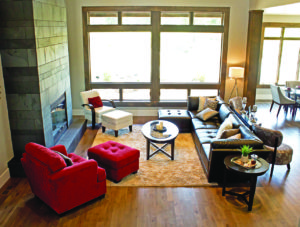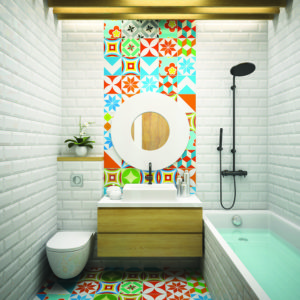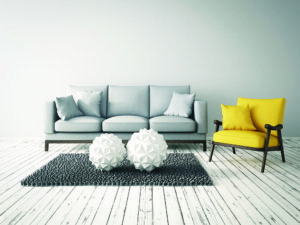Trending
Home Styles: Defining Your Style - Know it, see it, love it!
By Vanessa Roset
February, 2017
 Bye-bye, winter blues! Spring is just around the corner, and for many of us, it’s a time for renewal. We clean out closets, open windows and air out stale and stifled spaces. This year, why not kick your spring cleaning up a notch with a little re-decorating? After all, studies show that a properly designed room has positive effects on our mood, sleep and stress levels. Ready to get started? Here’s a “cheat sheet” for customizing a sanctuary of your own.
Bye-bye, winter blues! Spring is just around the corner, and for many of us, it’s a time for renewal. We clean out closets, open windows and air out stale and stifled spaces. This year, why not kick your spring cleaning up a notch with a little re-decorating? After all, studies show that a properly designed room has positive effects on our mood, sleep and stress levels. Ready to get started? Here’s a “cheat sheet” for customizing a sanctuary of your own.
Traditional
Style Summary: Formal but inviting, traditional décor is designed to be engagingly elegant. Think colonial-style homes where one can retire to the sitting room for a smoky after-dinner Scotch.
Iconic Moments: The traditional style has survived for centuries—it dates as far back as the 1600s and is often influenced by the refined preferences of the 18th and 19th century British Empire.
The Colour Palette: Traditional décor emphasizes cream-coloured neutrals and soft browns paired with pale hues and rich autumn-toned accents. Florals, stripes and/or damask patterns are also used to add interest without being overwhelming.
Materials & Textiles: Rich woods such as cherry, oak and walnut are used for floors, railings and stairwells. Plump pillows, furniture skirts and tasselled floor-to-ceiling drapes add a quiet finesse, as do bronzed-metal light fixtures and crystal chandeliers.
Lines & Spaces: Rooms often feature detailed, decorative moulding and elegant archways. The smooth edges and cozy curves soften the formality of the style, which is geared toward tranquility and comfort. Furniture is symmetrically arranged to encourage conversation between guests.
Modern
Style Summary: Modernism is all about easy living. It’s clean and efficient, simple but sleek. Think naturally sunlit loft spaces with wide-open floor plans and lots of chrome appliances.
Iconic Moments: Modern décor stems from a rejection of the extravagant Victorian and Renaissance styles of the 1800s.
The Colour Palette: Go heavy on the neutrals, and mix them with subtle warm tones. Embellish with a single bold-coloured accent or symmetrical graphic pattern—the mood should be welcoming but not overly energetic.
Materials & Textiles: Natural wood, cork or linoleum floors are subtle and unembellished. Stainless steel and polished chrome prevail, while textiles are kept soft, neutral and sparse. Backsplash tiles are often used to complement the space.
Lines & Spaces: The style features clean, straight lines and geometric shapes. Incorporate frameless cabinets, inset shelving and go for fewer dividing walls and for large, uncovered windows. Minimalism is key—there is no visual clutter, and the functionality of each piece is carefully considered.

Art Deco
Style Summary: Art deco has all the makings of a Hollywood icon: it’s glitzy and glamourous, theatrical and fun. Think swanky downtown penthouse with slick retro furnishings and a view of the stars.
Iconic Moments: The style thrived from the late 1920s to the early 30s, when it was embraced as a welcome distraction from the difficult struggles of the Great Depression.
The Colour Palette: You can’t go wrong with the classic black-and-white combination, but flashes of bright colour, metallic paints, bold artwork and neutral backdrops will help add an alluring elegance to the space.
Materials & Textiles: Shine, baby, shine! Go for glossy floors, lacquered surfaces, chrome finishing, polished silver and gold fixtures and mirrors of all types. Pair them with leather, vinyl, animal prints, silk and satin.
Lines & Spaces: Symmetrical, geometric shapes rule the art deco world. Bold, angular lines are balanced out with smooth, sultry curves. Patterned rugs and wallpapers provide pizzazz, and moody statement lighting is a must.
Eclectic
Style Summary: Anything goes with this all-encompassing style, which combines
elements from different time periods and types of décor. Think San Francisco-artist’s-
apartment-turned-studio-space.
Iconic Moments: Eclectic décor was a reaction to the existing styles that were considered overdone and “boring” and was particularly popular in Europe and Russia during the 1830s.
The Colour Palette: Eclecticism isn’t restricted by a colour code. So experiment with all shades—just do it cohesively, not chaotically. Walls are often kept neutral to showcase diverse arrangements of art. Accent walls or ceilings and bright window treatments will add extra flair.
Materials & Textiles: Embrace texture and contrast. Place woven rugs over cork flooring; mix soft, supple fabrics with coarse textiles. Balance wood with metals, shiny objects with matted ones. There’s a place for glass, plastic, ceramics and tile.
Lines & Spaces: Straight, curved, soft, edgy—anything works, but always consider parallelism when designing a space. Use related shapes and colours throughout each room to tie in pieces from different eras and locations.

Arts and Crafts
Style Summary: The arts and crafts movement stresses a deep connection to our natural surroundings. Think handcrafted bungalow with a wood-burning fireplace, exposed beams and a wrap-around porch.
Iconic Moments: The style took off in the late 1800s in opposition to the lavish trends of the Victorian era. Supporters favoured
simple, natural craftsmanship over the ornate, mass-produced furnishings that prevailed.
The Colour Palette: Look for the warm, earthy colours that are found in natural foliage: lush greens, deep yellows and wood tones. Avoid pastels, and use brighter colours sparingly, or mute them with a worn-out finish.
Materials & Textiles: Natural wood stained to highlight the grain is a huge feature, as is stone and warm-toned metals such as bronze and copper. Decorative touches are added with tiles, stained glass and simple upholstery.
Lines & Spaces: Solid, straight lines dominate—hardwood or stone-tiled floors, heavy wood furniture, and windows letting in natural light onto open floor plans. Visual clutter is minimal; the focus lies on the artistry of the space itself.
Shabby Chic
Style Summary: Sometimes referred to as “cottage décor,” this style adds subtle modern accents to flea-market favourites to create a charming, vintage feel. Think French-inspired character homes, with antique dressing tables and ornamental mirrors.
Iconic Moments: The term “Shabby Chic” was trademarked by British designer Rachel Ashwall, who moved to America and avidly promoted the style, which she fashioned in the 1980s.
The Colour Palette: Whites and ivories and creams reign supreme and are paired with pastels or neutral tones, with an occasional pop of colour. Freshly painted pieces are sanded down and distressed for a weathered look.
Materials & Textiles: Natural textiles abound in this style: soft cottons and linens are peppered with lace and faded, feminine prints. Slip covers, braided rugs and delicate, flowing curtains complement natural wood flooring and rustic brick and stone.
Lines & Spaces: Soft edges, smooth curves and straight lines mix as mismatched furniture shares the space. Textured panelling is extremely popular, as is the use of open shelving instead of standard cabinets. t8n
Design Tip
Open-ended styles offer lots of flexibility but require some forethought to avoid appearing messy. Plan out focal points for each space, and consider your furniture placement before filling a room with art and embellishments. Establish flow with consistent themes, and don’t overdo it on busy colours and patterns.












